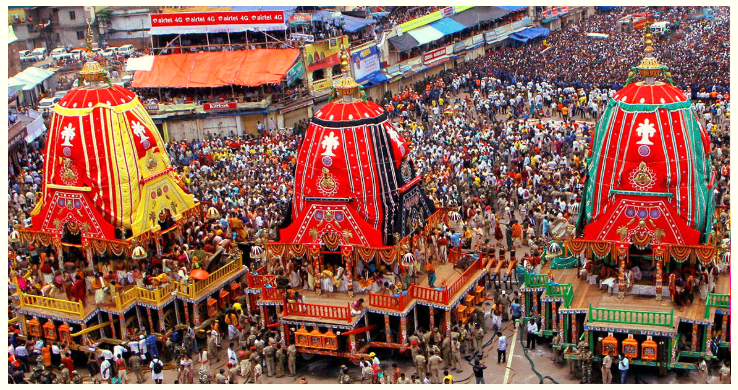Ratha Yatra on Sunday, July 7, 2024
Dwitiya Tithi Begins – 04:26 AM on Jul 07, 2024
Dwitiya Tithi Ends – 04:59 AM on Jul 08, 2024
India, known for its rich cultural tapestry, boasts numerous vibrant festivals that bring people together in celebration. One such captivating event is the Jagannath Rath Yatra, a significant Hindu festival that captures the essence of devotion, spirituality, and joy. This blog aims to delve into the details of this extraordinary festival, highlighting its historical significance, rituals, and the awe-inspiring journey of Lord Jagannath and his siblings.
Historical Significance:
Jagannath Rath Yatra, also known as the Chariot Festival, holds a special place in the hearts of millions of devotees. The festival traces its roots back to ancient times and is primarily associated with the city of Puri in the state of Odisha, on the eastern coast of India. The event centers around Lord Jagannath, an incarnation of Lord Vishnu, along with his siblings, Lord Balabhadra and Goddess Subhadra.
Rituals and Preparations:
Months prior to the Rath Yatra, the preparations commence with great enthusiasm. The sacred chariots, called “Raths,” are constructed with meticulous detail using specially chosen neem wood. Skilled artisans intricately carve and decorate the chariots, making them resplendent and awe-inspiring.
The festival begins with the ceremonious bathing of the deities, known as “Snana Purnima.” The deities are given a ritual bath with 108 pitchers of scented water, followed by a grand procession. This ritual symbolizes the rejuvenation of the deities’ divine powers.
The Journey of the Deities:
The highlight of the festival is the grand procession where the deities embark on a symbolic journey from the Jagannath Temple to the Gundicha Temple, covering a distance of approximately three kilometers. The deities are seated in their respective chariots, which are pulled by thousands of devotees who consider it an honor to participate in this divine endeavor.
The chariots:
Nandighosa (Chariot of Lord Jagannath): It stands at an impressive height of 45 feet and has 18 wheels, each representing different attributes of Lord Vishnu.
Taladhwaja (Chariot of Lord Balabhadra): It stands at a height of 44 feet and has 16 wheels, symbolizing the qualities of strength and valor.
Darpadalana (Chariot of Goddess Subhadra): This chariot, standing at 43 feet tall, has 14 wheels, representing beauty and grace.
Thousands of devotees from all walks of life gather along the route, chanting sacred hymns and pulling the chariots with immense devotion. The atmosphere is filled with euphoria as the chariots inch forward amidst the jubilant crowd.
The Return Journey:
After a stay of about a week at the Gundicha Temple, the deities commence their return journey, known as the “Bahuda Yatra.” The return journey mirrors the grandeur of the initial procession, albeit in reverse, as the deities make their way back to the Jagannath Temple.
Conclusion:
The Jagannath Rath Yatra is an extraordinary festival that encapsulates the essence of faith, devotion, and unity. It symbolizes the journey of the divine deities, their bond with their devotees, and the eternal cycle of life and spirituality. The festival is a testimony to the vibrant cultural heritage of India, attracting visitors from across the globe to witness and experience the divine grandeur of Lord Jagannath’s Rath Yatra.


